Why I Love Teaching Touch for Health Kinesiology
Why I Love Teaching Touch for Health Kinesiology
I love teaching Touch for Health! Of course I have a passion for the material and the ethos – who doesn’t? But I also love Touch for Health because it gives so much scope to have fun and be creative.
We all know that children learn best through play and activity, when they aren’t aware that what they are doing is part of the learning but just feels like playful fun. I wanted the same feel in my TFH classes so I try to have plenty of playful activity at each level. Now when I prepare my resources for a weekend workshop I have a whole selection of materials to help us with our learning – wool, stickers, marbles, coloured card, wooden wheels, string, coloured pens, flash cards, cartoon drawings, music, giant post-it notes - anything at all to help make learning fun and interactive.
For example, I was inspired by an eTouchforHealth Newsletter from Earl and Gail Cook. They used coloured wool to trace out the meridians and I now use this idea as the basis for a large part of a Touch for Health level 2 Class. In pairs the students take five minutes or so to stick the appropriately coloured meridian on each other using sticky or surgical tape. We can now see how all the meridians look. When we all stand in a circle in meridian order we can see that the meridians run in a continuous flow, one starting where the previous one ends. We can also clearly see the colour patterns, the Yin and Yang aspects and so many other features at a glance. This is a really simple example of how a fun activity can really enhance learning. Students soon find it all falling in to place and easy to grasp without much effort – but lots of tape!
Naturally, all the information is then reinforced in other ways, particularly for the auditory learners and those who would like to take notes to ensure that all learning styles are catered for.
The possibilities for playful learning within the TFH synthesis are enormous. I encourage everyone to tap in to their creative selves not only in class but also when they begin to help friends and family to reach their goals and improve their health. Being creative intrinsically results in being open to the possibilities - which is what TFH is all about!
